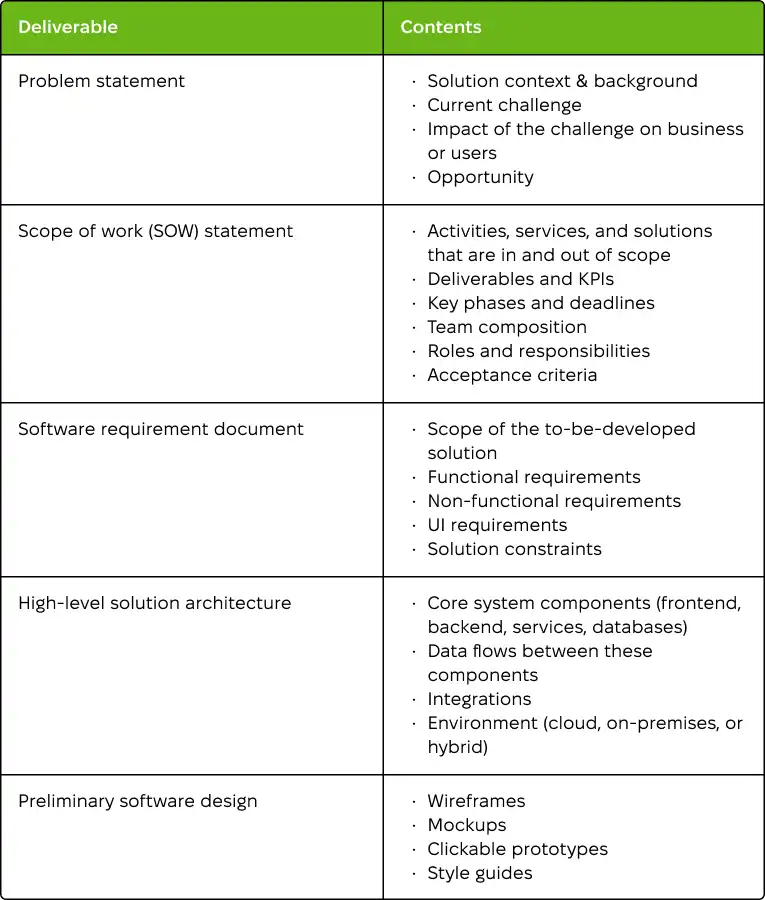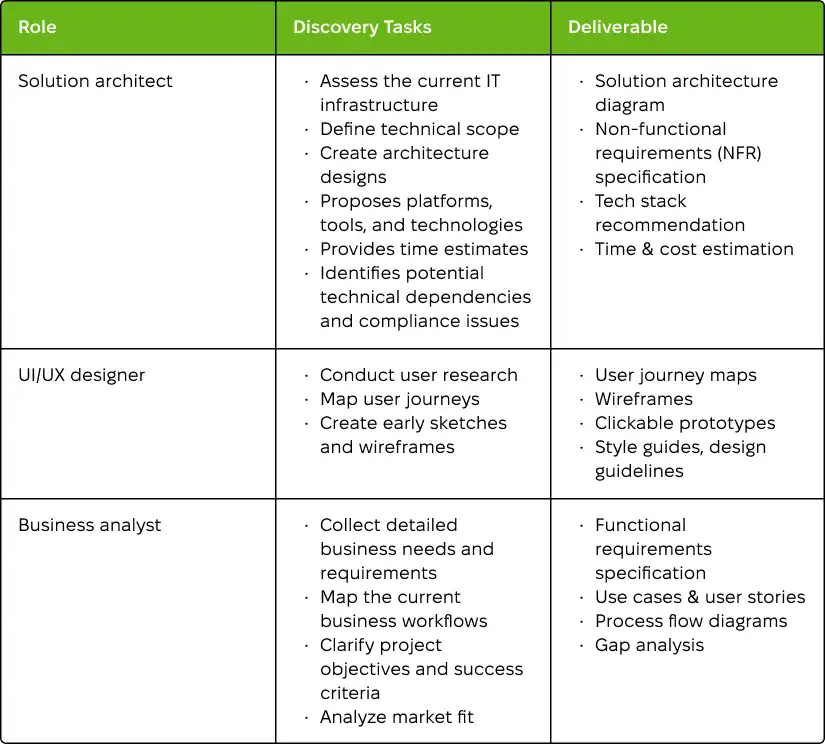The picture behind every IT project is inspiring. However, underneath, you get tough decisions to make, details to refine, and dependencies to manage. The Discovery Phase is what helps you turn that early vision into a realistic plan. In the end, you get a defined scope, clear timelines, prioritized features, and technical direction.
Houses built without proper planning might not crumble overnight. Yet, as time passes, residents notice leaky ceilings, poor airflow, or crooked floors – things a solid blueprint could have prevented from the get-go.
A similar principle applies to
software development projects. A poorly planned solution might function and get applause from your stakeholders. Under the hood, though, it would be running on a poor architectural structure, scattered data flows, and technical debt. You end up spending more and more just to deal with constant emergencies.
Good preparation and planning are the antidote to such a scenario. That’s why most software development companies (Exoft, too) start our engagements with a discovery phase. We prepare a solid foundation before mounting the first lines of code.

Source: Spotify Design
What Is the Discovery Phase in Software Development?
The discovery phase is the preliminary process that shapes your project roadmap and determines the best way to execute it. Done before any development begins, it helps you refine project vision, feasibility of ideas, budget, timeline, and technology choices.
The discovery phase unfolds as a series of workshops, usually 2-6 remote or on-site meetings. If needed, focus groups and user surveys can also help.
A well-performed discovery stage allows you to:
- Ensure that your solution fits the market demands
- Understand the expectations, needs, and desires of users (user requirements)
- Anticipate potential constraints (legal regulations, compliance requirements, IT infrastructure needs)
- Define the scope and boundaries of your solution, its feature set
- Estimate the time, resources, and budget needed for the whole development process
- Select the necessary tech stack and team qualifications
For your IT vendor, discovery is the first checkpoint. We need to understand your solution, and the business needs to commit to a specific result, KPIs, or SLAs. It's especially true for outcome-based delivery models, like Managed IT Services or Fixed-Price Projects.
For you, discovery is a chance to evaluate whether your IT vendor is reliable. Reputable IT partners, like Exoft, often treat discovery as a prerequisite for a transparent, results-driven development process. Good project understanding helps us understand whether we're a good fit for you. Strategically, discovery findings help us avoid scope creep, budget overruns, and project delays (which in turn lead to better service quality).
The process is as follows:
- You share information about your solution: anything from raw ideas and early assumptions to product documentation, metrics, or user feedback.
- We analyze your input, identify data gaps, and prepare any extra questions.
- With each new meeting, we refine your requirements and scope.
- In the end, we provide you with a set of deliverables.
Core Discovery Phase Deliverables
| Deliverable | Contents |
|---|---|
| Problem statement |
|
| Scope of work (SOW) statement |
|
| Software requirement document |
|
| High-level solution architecture |
|
| Preliminary software design |
|

How Long Should a Discovery Take?
There's no fixed duration for the discovery phase. Depending on the project complexity, we can spend from a few weeks to several months:
- Between 2-6 weeks: For simple MVPs, small-scale apps, or simple changes in well-supported systems
- Approximately 1-3 months (and more): For large-scale, complex, integration-rich systems with many dependencies
The maturity of your project vision also affects the overall timeline. Well-prepared product requirements and documentation mean less work during discovery. Meanwhile, raw ideas and vague specifications call for more in-depth research.
The duration also depends on how collaborative your stakeholders are. Consistent and open communication gives us better insight into both the tech and business side of your solution.
Wondering if you can speed up your IT project? Let Exoft make all time and effort estimations.
Who is Responsible for the Software Discovery Phase?
The discovery phase brings experts from both sides: the delivery team and your internal stakeholders. On the vendor side, a typical discovery team includes a UI/UX designer, a business analyst, and a software architect. You can add other optional roles: data engineer, QA lead, DevOps engineer.
Project Team for the Discovery Phase
| Role | Discovery Tasks | Deliverable |
|---|---|---|
| Solution architect |
|
|
| UI/UX designer |
|
|
| Business analyst |
|
|
| Data engineer (optional, for data- and AI-related projects) |
|
|
| QA lead (optional, for projects solely dedicated to testing) |
|
|
| DevOps engineer (optional, for infrastructure-related projects) |
|
|

The discovery phase isn’t a one-way street. You also need to provide extensive input. We’ll usually ask our clients to engage key stakeholders: product managers, technical leads, architects, or the CTO. In an ideal scenario, we’ll also benefit from access to end users (or people representing them). The more complete the picture, the more accurate the discovery will be.
When Should You Consider a Discovery Phase?
Discovery often occurs organically on projects — even if you don’t call it that. If you’ve ever had communication sessions with your vendor to collect product data and sort out requirements, you’ve already done some version of the discovery.
However, there are scenarios where such an ad-hoc approach isn’t enough. A formal, in-depth, and standalone discovery phase is necessary when you:
- Have a raw product idea, but lack understanding of how to bring it to life
- Deal with innovative solutions with no direct market equivalents
- Lack project understanding for precise time and budget estimates
- Need to identify the best technical approach and tools for development
- Need to account for regulatory and compliance requirements
- Require an impartial second opinion about plans devised by your in-house team (for discovery as a standalone service)
Your IT vendor may suggest a discovery phase if they believe there’s a more modern or simpler approach than the one you currently have in place. If you deal with legacy systems, the vendor might need several sessions to understand the technologies and dependencies.
In all these scenarios, discovery sets the foundation for both building the right product and building this product right.
Kick off Discovery with Exoft to lay the groundwork for a scalable, efficient solution!
Benefits of a Discovery Phase
The Discovery phase is so often recommended for a reason: it minimizes delays and budget overruns in IT projects. According to BCG, one in five C-suite executives report time and cost mishaps in more than 50% of cases.

Source: BCG
Well-conducted discovery phase prevents inefficiencies from the ground up, resulting in:
- Clear product vision: We understand the “why” behind your solution and how to achieve it.
- Feasible scope: We prevent your solution from overloading with redundant and overly complex features, keeping it balanced and avoiding scope creep.
- No hidden costs: By proactively accounting for all project details, we make more accurate time, scope, and cost predictions. This reduces the risks of budget overruns.
- Accurate timelines: We gain an understanding of your existing systems, the desired 'to-be' state, and available resources, allowing us to make a precise time estimate.
- Early risk mitigation: We account for all legal, compliance, and data governance requirements, identifying whether these lead to additional costs or delays.
- Better team productivity: According to Docker, development teams usually get stuck due to issues with planning (31%) and estimation (24%). A clear project roadmap and defined requirements help us prevent these productivity pitfalls. Plus, discovery enables you to assign the correct number of specialists to the project.
- Vendor evaluation: The discovery phase marks the first significant engagement with your potential IT partner. It’s a chance to evaluate their reliability, communication styles, and cooperation approaches before committing to a long-term relationship.
Example of a Discovery Phase in Software Development Projects
We partnered with one of our clients when they had only a raw idea for
a freelance marketplace. The company believed existing proofreading corporations to be overpriced and unreliable, so they decided to build a custom platform for editing and writing services.
With just an initial idea, this project was a textbook case for a discovery phase. We assembled a team of a solution architect and a UI/UX designer who delivered discovery in about 1.5 months. After several meetings, we provided the client with early UI/UX designs, estimates, budget-aligned scope, and other assumptions. By the end of discovery, we had a complete understanding of the future product, including:
- User roles
- Access and permission matrix
- Freelancer recommendation rules
- Pricing model, rate structures, and payment methods
- Information architecture
With all this information upfront, we successfully released the MVP of a solution in just five months. We’re currently expanding the solution with new features while maintaining the existing components.
Conclusion
Although project vision is a major driving force behind every project, you need a detailed, actionable plan to make it work. No matter how exciting the idea, a lack of clarity quickly leads to missed deadlines, wasted money, and frustrated teams
The discovery phase lets you avoid these scenarios right from the start. It helps you clarify what your users need, what your team can realistically deliver, and how to plan your budget so the project stays on track from day one.
